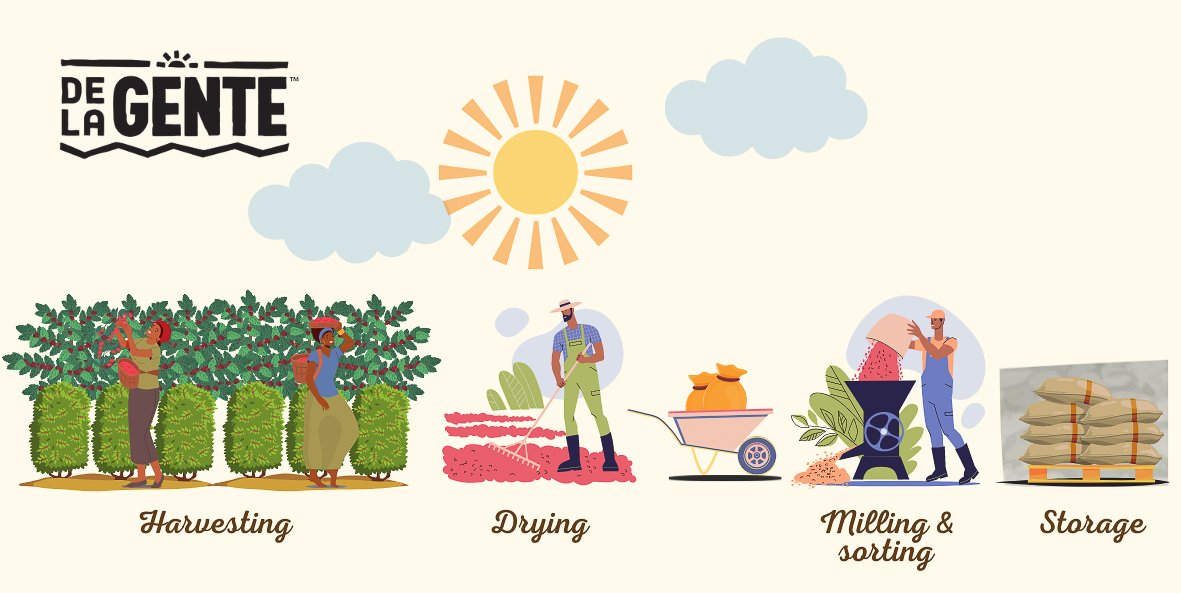Peculiarities of Guatemalan Natural Processed Coffee
Natural processed coffee originated in Ethiopia in areas with limited access to clean water, and it’s the oldest process of all. Nowadays, countries like Indonesia, Vietnam, Kenya, Guatemala, Honduras, and the list goes on, continue to produce it for its popularity and intense flavor.
In the coffee-drinking community, there's a big misconception about what natural process and organic coffees are. In a nutshell, when we talk about natural processed coffee, we talk about the method that was created to process the coffee fruits after they have been harvested using minimum water. Organic coffees are the ones where the coffee trees and surrounding natural environment have been taken care of and nourished without the use of chemicals.
What is Natural Process?
Going more in-depth about what this process is all about, it begins after the fully ripe coffee fruits have been harvested. In Guatemala the harvest is done by hand without the use of machines. After the harvest, the beans are immediately put to dry on drying patios or raised beds under the sun for about two weeks. The result of drying the entire fruit with all of its layers and sugars is an intense earthy and fruity flavor.
Natural Processed Coffee in Guatemala
We spoke to Manuel Gómez, a coffee producer from our partner cooperative, Coffee Growers of San Miguel Escobar in the Antigua growing region, about the special care and good practices when he processes his natural coffee microlot:
What are the special cares you take during the natural process of coffee?
First, I have to harvest only the right coffee cherries so that later, during the drying period, I get better results. By that, I mean that I don’t let the coffee cherries over-ferment on the branches or don’t harvest the ones that are not fully ripe.
That doesn’t mean I don’t pay attention to the drying stage. Unlike the wash process, the natural process needs to be moved twice as much [daily]. For example, in the washed process, my family and I move it four or five times a day. In the natural process, we move it ten times a day from 11 am to 3 pm, that is when the sun is stronger. That helps the coffee to dry more evenly because if you don’t move it, you’ll get over fermentation and funguses that result in a bad taste.
What is the importance of letting the coffee dry to its optimum state?
Letting the coffee cherries dry with all their natural sugars and moving them constantly, allows them to have the distinct fruity flavors of the natural processed coffees, and the beans get a more even color.
For how long do you leave the coffee to dry?
The number of days I let my coffee dry depends on the amount. For 1,500 pounds of coffee cherries, I use 30m2 (≥ 323 ft2) of space to lay them out. Those coffee cherries take 20 to 22 days to dry depending on the sun and the clouds.
What is the difference between drying the coffee on drying patios and drying raised beds?
There's a big difference in the outcome if people don’t take adequate care when using drying patios. By that, I mean that if you dry your coffee on patios that haven’t been thoroughly cleaned beforehand, your coffee will absorb dust and, in our case being so close to an active volcano, ashes too. In the end, your coffee will have cardboard, earthy, or moldy flavors. Another difference is that when using drying patios, the coffee may dry faster because there's no air circulation and the concrete heats up.
When using drying raised beds, there's more air circulation. Also, when you move it, all of the dust, little branches, and all of that organic material that comes with the coffee falls off.
In the southwest of Guatemala, in the Atitlan coffee growing region, another of our partner cooperatives, Ija’tz, produces a blend [from 35 producers] of natural processed coffee. This cooperative was established in 1995 with the goal of reclaiming and protecting the land and the surrounding environment while revitalizing traditional agriculture processes. Since its founding, Ija’tz Cooperative has incorporated cultivating arabica coffee, grown under the shade of native plants and trees, which aids in carrying out their commitment to environmental preservation and providing economic stability to its 35 members.
They began processing natural lots in 2018, exporting only two sacks of 150 pounds each with De La Gente. In 2024, they will export 15 sacks. Their values align with the idea of using small amounts of water to produce coffee, and they are doing a fantastic job with their natural processed coffee. Tristan Lefever, specialty coffee roaster and friend of DLG says:
“Natural Guatemalans are just not common, especially at that time [year 2018] but even now are harder to come by. In 2018 we had never seen one […]
Washed Guats are typically very chocolatey, and a lot of roasters use them for espresso or medium blends; for example, we might look for a washed Guat to blend with an Ethiopian natural because you get the fruity Ethiopian notes with big rich chocolate of the washed Guat, and that is a great balance. But- the Ija’tz natural had both- cherry liquor, light nut-like pistachio and hazelnut, and then this big chocolate base.”
Order samples








